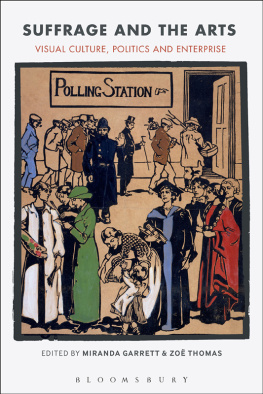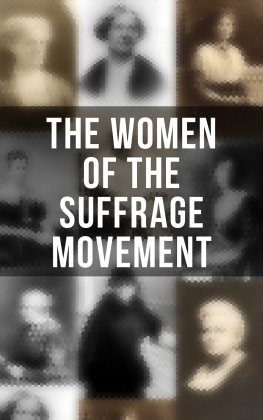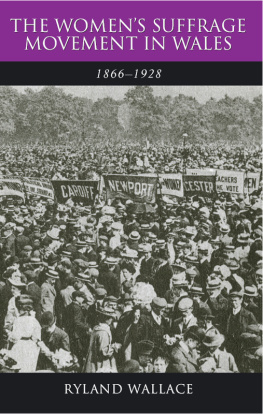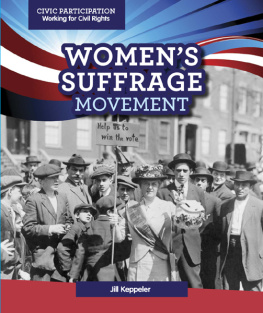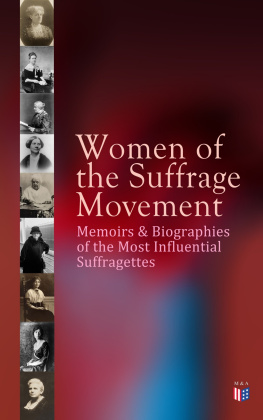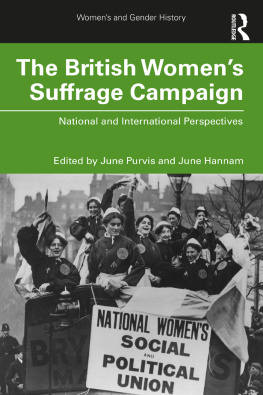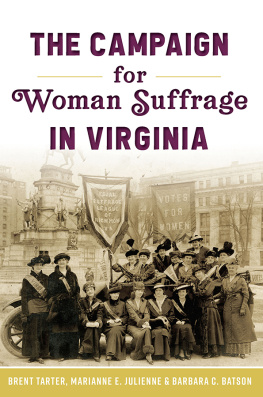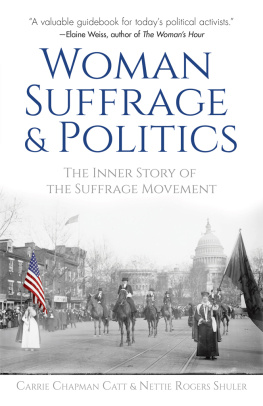Suffrage and
the Arts
Suffrage and
the Arts
Visual Culture, Politics and Enterprise
EDITED BY MIRANDA GARRETT
AND ZO THOMAS

Figures
Plates
We would like to thank Jane Beckett, Deborah Cherry and all the authors who have contributed chapters to this book for their hard work and enthusiasm, as well as Claire Constable, Rebecca Barden and Vinita Irudayaraj at Bloomsbury for their help and patience. Thank you to our contributors Ken Florey and Janice Helland for reading and commenting on the Introduction. We are grateful to the following people for providing invaluable support during the research, writing and editing of this book: Irene Cockroft, Peter Cormack, Caroline Dakers, Lis Darby, Amy Montz, Simon Thomas Parsons, Helen Pankhurst, Francesca Peschier, Lucy Ella Rose, Sarah Sexton and Judy Willcocks. Beverley Cook, from the Museum of London, and Gillian Murphy, from the Womens Library, London School of Economics, were most kind in their speedy and supportive responses to endless image requests. Special thanks to Lyndsey Jenkins for reading the Introduction and for fruitful conversations about suffrage, feminism and modern British history. Finally, we are grateful to Central Saint Martins, University of the Arts London, the TECHNE Doctoral Training Partnership, the University of Birmingham, and a grant from the late Isobel Thornley Bequest at the University of London for providing financial support for the inclusion of colour images within this book.
Jane Beckett and Deborah Cherry
In the Peoples Palace in Glasgow is a ceramic cup and saucer, decorated with a thistle motif in the colours of the Womens Social and Political Union of purple, white and green ( This ensemble highlights the extensive span of the campaigns for womens suffrage across mainland Britain and Ireland. It demonstrates a transformation of the suffrage campaigns in the early twentieth century through a widespread address to visual, design and public cultures which exploited the new consumerism, marketing and branding in conjunction with the new visual media of the new century. The spectacular banners and massive processions are now well-known. Equally significant, and these are the stories told in this book, were the productive and myriad alliances between womens suffrage and the arts. Suffrage tactics encompassed the design of objects, such as this cup and saucer, that announced allegiance, promoted the cause and raised funds.
The tableware would have been part of a tea service produced for the Womens Social and Political Union Grand Suffrage Bazaar and Exhibition held at Glasgows St Andrews Hall, 28 to 30 April 1910, after which it was offered for sale. Treasured and carefully cherished, it was donated, with other suffrage materials by suffragette Janet Barrowman to Glasgow Museums in 1955. Since 1928, when all women in the British Isles gained the vote limited enfranchisement had been enacted in 1918 substantial museum, library and archival collections have been amassed. Among these collections are numerous personal possessions, institutional records and documents, a wide range of printed ephemera such as posters, tickets, pamphlets, handbills, along with photographs, badges and banners, newspaper clippings, printed books, letters and diaries. Yet what has survived is uneven, fragmentary and partial and, despite a seeming plethora of materials, from hand-written letters and printed materials, to suffrage ware and film, it can be difficult to assess today how what has survived relates to what once existed. Materials from
Major collections of womens suffrage materials entered the public domain in the 1920s, in the years just before adult suffrage was granted to all women in Britain in 1928. The papers of Lydia Becker (18271890) and Millicent Garrett Fawcett (18471929), along with the records of the Manchester Womens Suffrage Society, were given by Margaret Ashton to Manchester Central Library in 1922. The sheer richness and vividness of suffrage archives and collections has hugely enhanced knowledge and continues to generate new findings, resulting in a complex set of interlocking histories. But how are these histories formed?
The build up to the centenary of 1918 has seen plays, films and publications, including a small paperback in the Penguin Little Black Classics series entitled The Suffragettes. With a selection of pamphlets, posters, newspaper articles, photographs and speeches, its forty-six pages offer a brief history of womens struggles for the vote, encapsulating a microcosmic varied landscape of the geography, politics, key figures, visual campaigns, language and arguments for and against womens suffrage in the late nineteenth and early twentieth centuries.
Historical and visual research has enlarged the whole field of suffrage studies far beyond this concise introduction. Suffrage campaigners wrote early accounts and assembled collections, and living memory has played a highly significant role. When Jill Craigie (19111999) encountered a group of elderly women who annually assembled at the grave of Emmeline Pankhurst (18581928), these pioneering suffragettes, who considered that their struggles had been forgotten, were astonished to find a young woman joining them; the encounter inspired the socialist, feminist and film-maker to amass a substantial archive, now housed at the London School of Economics.
A considerable body of historical work on the suffrage movement emerged from Gender Studies and Womens History departments, and while they are still studied in British universities, there have also been significant closures. It could be argued that these courses emerged from the struggles of the suffrage movement for changes within different areas of womens lives. The historic womens studies programme at Ruskin College, like its international labour and trade union courses, has been axed despite strong protests. Although womens suffrage became part of the national curriculum of secondary education in schools in 2013, this was only at Key Stage 3 and as a non-statutory element of the broader brief for challenges for Britain, Europe and the wider world: 1901 to the present day.
Most accounts of womens suffrage in the British Isles initially set out from binary trajectories, tracing the initiation, growth and development of what are perceived as the two main societies: the Womens Social and Political Union (formed 1903) and the older National Union of Womens Suffrage Societies (formed 1897). In laying out this ground, the usual focus has been on the pivotal roles played by the Pankhurst family on one side and the Fawcett/Garrett dynasty on the other. These accounts were fashioned from outlines in the memoirs, autobiographies and early histories written by participants.
One predominant suffrage narrative contrasts the militancy of the Womens Social and Political Union and, in part, the Womens Freedom League, against the constitutional strategies of the National Union of Womens Suffrage Societies, excavating and valorizing these accounts through re-reading memoirs, diaries and letters.
Suffrage activity in Suffolk and Norfolk was enabled by the considerable range of suffrage committees and organizations laid down across East Anglia in the nineteenth century.
Campaigns by women teachers consistently built on the principle of equal rights. Stemming as Oram points out from liberal political philosophy, they emphasized womens rights as citizens, property-owners and taxpayers. They stressed the social responsibility of their role as teachers of future citizens to insist that, like their male counterparts, they should have an equal say. At successive meetings and conferences of the National Union of Teachers, they put forward motions to express [t]hat this Conference expresses its sympathy with those members of the National Women of Teachers who desire the Parliamentary franchise, but because they are women and for that reason alone, are by law debarred from it. This motion was hotly debated at the National Union of Teachers Conference of 1914 held in Lowestoft, advertised in
Next page
